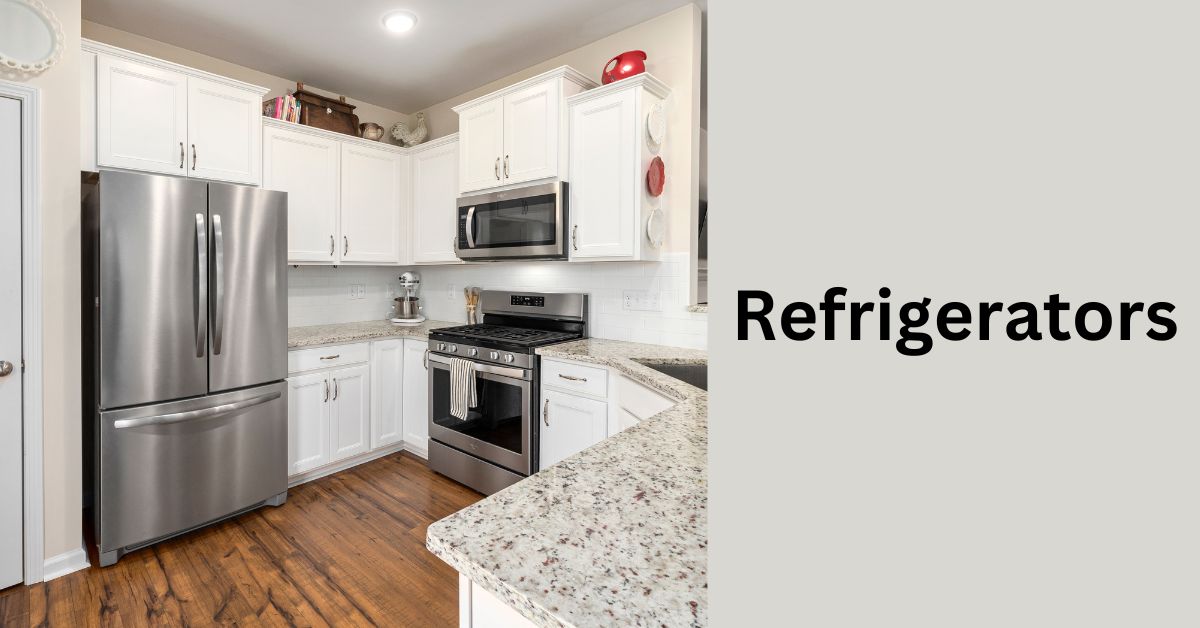Table of Contents
Note: If you came to this post on the refrigerator through a random search, please click on this parent page and our home page for more context.
Refrigerator – First Appliance to Consider
The refrigerator (fridge-freezer) should always be top of mind in a kitchen remodel project. We discuss your refrigerator options below and make some recommendations.
The fridge is going to be the first appliance on your list. This is because it is the biggest, takes up the most space, and should take priority as it gets designed into the kitchen.
It is also the most expensive of the appliances. So, depending on your budget, it is the item where you stand to save the most.
What Type of Refrigerator is Best?
Depending on your kitchen layout, budget, and preferences there are four main types of fridge-freezers to think about.
We’ll Look at These Four Refrigerator Options
- Built-in refrigerator
- Freestanding refrigerator
- Counter depth refrigerator
- Under counter refrigerator
Full-size Refrigerators Only
Since this Guide is all about home remodeling, we will not be looking at small apartment-size refrigerators or Euro refrigerators.
When you are remodeling, you need to have in the back of your mind the ultimate resale of the property. And, if you are remodeling a regular home, the resale market will expect to see a full-size refrigerator in the kitchen. It will at least expect a designated space for it with an electric and water supply.
However, you might want to consider an apartment-size refrigerator in a secondary location, like a home office.
Built-in Refrigerators
The built-in refrigerator is designed to be installed flush with and surrounded by cabinetry. It is front-vented. It can come with a “panel-ready” option, allowing you to match the front of the refrigerator to the cabinets.
The built-in refrigerator looks great but comes with a hefty price tag in the $7,000 plus range. In addition, because they are flush with the cabinetry, they take up additional linear feet to make up for otherwise lost volume in depth. On the other hand, this “shallow” feature makes it easier to identify and reach the things that are in the refrigerator.
Why are Built-in Refrigerators so Expensive?
There is no doubt that part of this is “perceived value” and “what the market will bear.” These are marketed as high-end items and there are plenty of people happy to pay an inflated price.
On the other hand, there are substantive reasons for the high cost too. Unlike the standard fridge, the built-in will have a separate compressor for the freezer compartment. They also come with superior controls, better humidity control, and better shelving arrangements.
In addition, they are usually “panel ready.” See below for more on this.
The built-in refrigerator looks great and works well. However, when it comes to pure “value for money,” there are better options.
Built-in Refrigerator on Amazon
ZLINE Panel Ready Built-In 3-Door French Door Refrigerator
- Internal Water and Ice Dispenser
- Soft-Shut Technology
Freestanding Refrigerators
The freestanding refrigerator is finished on the front, both sides, and top. It can be placed to the side of a counter with no custom cabinetry work needed. However, it usually fits within a purpose-made alcove in the cabinetry with storage space above.
Except for the under-counter refrigerator, this is the most budget-friendly option. It is also the most recognizable.
Freestanding Refrigerators on Amazon
ZLINE 2.5 cu. ft Freestanding French Door Refrigerator
- Ice Maker
- Fingerprint Resistant Stainless Steel with Champagne Bronze Accents
Counter Depth Refrigerators
A counter-depth refrigerator is a free-standing unit designed to appear flush with the lower cabinet fronts. It offers a much more finished look than the regular freestanding refrigerator.
Do counter-depth refrigerators have less space? No. The loss of volume front to back is usually compensated for by increased width. Although some designs make up for it in extra height.
Be aware that, unlike the built-in refrigerator, the counter depth version is usually not front venting. This means that you have to allow for manufacturer-specified ventilation gaps to the sides and top.
And, as with the built-in refrigerator, the counter-depth refrigerator takes up more linear space. But this makes it easier to see and reach the fridge contents.
Some counter-depth refrigerators come with a “panel-ready” option. This allows you to match the front of the refrigerator to the surrounding cabinetry.
Counter-depth Refrigerator on Amazon
Under-Counter Refrigerators and Freezer Drawers
The under-counter refrigerator-freezer is not typical but is gaining favor.
An alternative or addition to the side-by-side refrigerator, but with less cubic capacity, is the under-counter refrigerator or freezer drawer.
While the under-counter fridge-freezer is a great option for small kitchens, most households would have these as a supplement to the main refrigerator and perhaps use them just to help with entertaining. In this case, the main fridge could be smaller than otherwise required.
But for someone living alone, they could be a substitute for the main fridge and a major space saver because of it.
However, we look at this from the point of view of a remodeling project, which always has an eye on eventual resale. So unless you are working with a really small kitchen, the under-counter refrigerator-freezer will only be a supplement to the main refrigerator.
Under-counter refrigerators typically fit into a standard 24” or 36” cabinet opening. The built-in type will be flush with the cabinetry and vent from the front. The freestanding version will require ventilation space on both sides and the top to prevent overheating.
Under-counter Refrigerator-freezers on Amazon
Choosing a Refrigerator
Within the basic configurations we have described, there are many types of refrigerators to choose from. Here are things to consider.
Size of Refrigerator
The starting point in fridge selection is size. This includes the total and relative sizes of the refrigerator and freezer storage compartments.
Industry experts tell us that we need between four and six cubic feet of total storage space per person in the family. That’s actually quite a large spread. But in round numbers, a family of four needs a 20 cubic feet capacity fridge.
And then you need to decide how much of that should be freezer space and how much regular refrigerator space.
Fortunately, because you are remodeling your kitchen, you probably already have a very good handle on the size of refrigerator you need based on your shopping, cooking, and entertaining practice and experience. Nonetheless, because you are getting a new refrigerator, it’s a good idea to pause and consciously think this through.
Refrigerator Design and Door Style
You probably already have your own preferences as to design and style and we wouldn’t want to talk you out of them. However, with our remodeling hat on, it’s appropriate to touch on two things;
Ergonomics
Some types of fridges are easier on the human body than others. And you will notice that many are advertised as ADA-compliant, meaning that the designer has made a special effort to make the unit accessible. This is definitely a consideration for an aging-in-place kitchen.
Impact on Space
Some types of fridges, especially door style, work better with the flow of movement in the kitchen than others.
Freezer on Top of Refrigerator
The top-mounted freezer refrigerator has wide swing doors. These intrude well into the traffic aisle. Plus, since the refrigerator is the most used compartment, you are having to stoop and bend a great deal. This is not good from the point of view of Universal Design or aging in place.
Freezer on Bottom of Refrigerator
While the bottom mount freezer makes it easier than the top mount to see and reach the food you need most, it still has intrusive wide-swing doors.
Side-by-Side Refrigerator-Freezers
There are two types of side-by-side refrigerators.
- The standard arrangement is with the freezer on one side and the refrigerator on the other.
- The French door refrigerator has the fridge above and the freezer below.
Both have the virtue of limiting the size of door swings into the walkway aisle. This increases ease of passage and reduces the risk of injury
Are French-Door Fridges Better?
Yes. We feel that the French door arrangement has the edge. And the market thinks so too, as they are very popular.
The fridge compartment, which is the most used, is very spacious and fully accessible. The doors have long vertical handles, making them easy to grip from any position. It is easy to open either compartment with minimum reach and strain
The only compromise is that the freezer in the French door refrigerator is located at the bottom in full-width freezer drawers. The logic of the compromise is that the refrigerator space is by far the more frequently used.
Although stooping is required, the contents of the freezer are more visible and accessible than with the freezer compartment in the side-by-side arrangement.
Wall Recessed Fridge
There’s no doubt that the French door fridge can seem bulky and imposing. So, since you are remodeling, see if it can be recessed into the wall. Discuss the feasibility of this option with your contractor. If it is, you can gain about 3.5” of space in front of the fridge. This makes a surprisingly big difference.
Why are Panel-Ready Refrigerators so Expensive?
Some refrigerators are made “panel ready.” This means that they can accept decorative fronts that are in the same material and style as the surrounding cabinetry.
This requires a special door design. And the additional weight of the panels requires beefed-up hinges. And then, of course, there is the additional cost of the cabinet panels themselves.
However, as we mentioned earlier, a big part of what makes them so expensive is their cachet and “what the market will bear.”
Other Fridge Features to Consider
Shelving: Fixed or adjustable
Ice maker and water dispenser: Note that these require a connection to the water supply.
Energy efficiency: Check the EnergyStar rating.
Lighting: LED interior lights are longer lasting and use less energy than incandescent lights.
Individual Cooling Zones
Smart technology: this can include a WiFi connection, touch-screen control, and even a built-in TV.
Where to Place the Fridge in the Kitchen
There are only two rules regarding the placement of the refrigerator in a remodel project.
- Make the refrigerator a functioning part of the kitchen work triangle.
- Do not put it next to another major appliance.
- Related post: Kitchen Remodel Overview & Checklist
- Related post: Kitchen Layout
Integration Within the Kitchen Work Triangle
The kitchen work triangle is the long-standing paradigm for good kitchen design and function. It is sometimes called the “golden triangle.” This triangle is the relationship in the floor plan between the stove, the kitchen sink, and the refrigerator.
The National Kitchen and Bath Association (NKBA) tells us that no side of the triangle should be more than nine feet or less than 4 feet. They also say that the sum of all three sides should be not less than 13 feet nor more than 26 feet. And also that no major kitchen traffic should penetrate the triangle.
There is some modern thinking that holds that the work triangle is an outdated idea and that we should instead talk about “work zones.” And they have a point. We like to see the traditional cooktop/oven range function split between a separate oven and a cooktop. So should we be talking about a “work quadrangle” now? And we should include the kitchen island or peninsula in this thinking too.
As a practical matter, there is no need to get dragged into semantics. But the point should not be lost that the work triangle theory offers very useful guidance in arranging a functional kitchen.
So, when laying out your kitchen remodel, be sure to think through the placement of the fridge within the kitchen work triangle.
Not Next to Another Appliance
This is only common sense. For example, putting a fridge next to an oven or dishwasher is an obviously bad idea. The fridge is designed to get cold and the oven and dishwasher are designed to get hot.
If the fridge is forced to work harder and longer to compete with them. Its efficiency will go down and its energy consumption will go up. So this will cost more and reduce the life of the refrigerator.
The only exception to this rule is the under-counter refrigerator and freezer that are designed to be installed in this way.
Fridge Installation Clearances
Below are the main considerations when measuring your refrigerator installation.
Measure critical overall dimensions
The new fridge needs to fit. So measure:
- The width at the base, the upper cabinet, and the countertop.
- The height from the floor to the base of the upper cabinet
- The space at the front and back
- The space between the back wall and the front of the adjacent countertops
And see if there is an opportunity to recess the fridge into the wall behind.
Measure Fridge Door Swings and Drawer Pulls
- Make sure the fridge doors can open effectively.
- Take into account the angle of the door swings and the path of pull-out drawers
Make Sure That:
- You can stand in front of the fridge unit with the door open
- The doors can open to a 90-degree angle or better
- The doors do not obstruct the cabinetry
- The doors do not scrape walls or cabinets
- The doors do not interfere with walking aisles or other appliances
Space for Ventilation
Air must be allowed to circulate around the fridge for it to operate long and effectively. So these are the minimum ventilation clearances.
- 2 inches between the back wall and the back of the fridge.
- 1 inch above the fridge.
- I inch along either side of the fridge.
But always follow the manufacturer’s recommendations.
Refrigerator Delivery Clearances
Don’t forget to make sure your new fridge can actually be delivered to its designated destination. You must be sure that it will fit through doors and hallways on its way to your kitchen. Put the onus on the seller or delivery company to make this happen.
Which Brand of Fridge is the Best?
Our study of the review sites indicates that you can’t go far wrong with Samsung, Whirlpool, LG, Frigidaire, GE, and Kitchenaid.
- Related post: Wine Fridges









Leave a Reply